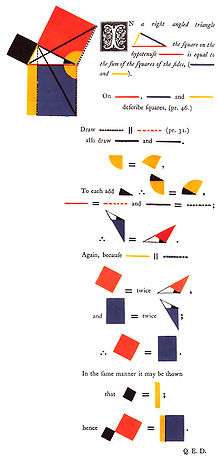Oliver Byrne (mathematician)
Oliver Byrne (/bɜːrn/; 31 July 1810 – 9 December 1880) was a civil engineer and prolific author of works on subjects including mathematics, geometry, and engineering. He is best known for his 'coloured' book of Euclid's Elements. He was a large contributor to Spon's Dictionary of Engineering.
Oliver Byrne | |
|---|---|
.jpg) | |
| Born | July 31, 1810 Avoca, County Wicklow, Ireland |
| Died | December 9, 1880 (aged 70) |
| Known for | His 'coloured' book of Euclid's Elements |
Family and early life
Byrne reports Avoca, County Wicklow, Ireland as his birthplace. The son of Lawrence Oliver Byrne and Mary Byrne,[1] he had a younger brother John who co-authored a book with him. Little is known about his childhood. He emerges in Dublin at age 20 with his first publication. Later in England, he was appointed Professor of Mathematics in the College for Civil Engineers at Putney.

Marriage
His wife Eleanor (née Rugg), was 12 years younger than Oliver and published meteorological articles and books. She is also featured on a token struck to commemorate Oliver Byrne's invention of Byrneore.
Byrne's Euclid
His most innovative educational work was a version of the first six books of Euclid's Elements that used coloured graphic explanations of each geometric principle. It was published by William Pickering (publisher) in 1847.
The book has become the subject of renewed interest in recent years for its innovative graphic conception and its style which prefigures the modernist experiments of the Bauhaus and De Stijl movements. Information design writer Edward Tufte refers to the book in his work on graphic design and McLean in his Victorian book design of 1963. In 2010 Taschen republished the work in a facsimile edition and in 2017 a project was launched to extend the work to the remaining works of Euclid.[2]
Byrne listed himself as a Mathematician, Civil Engineer, Military Engineer, and Mechanical Engineer and indicates on the title pages of one of his books that he was Surveyor of Queen Victoria's settlement in the Falkland Islands. Evidence shows Byrne never traveled to the Falkland Islands (see Hawes & Kolpas, 2015).
The U.S. Library of Congress has a steel-engraved portrait of Oliver Byrne.
Engineering and inventions
Byrne engaged in numerous railroad projects and invented mechanical devices including the following:
- The Byrnegraph
- The Gauger's Patent Calculating Instruments.
In 1842, Oliver Byrne and Henry William Hull (BA, CE) made a proposal for a School of Mathematics, Engineering, Classics, and General Literature at Surrey Villa, near Lambeth Palace.
Byrne was an anti-phrenologist, and wrote a book on the fallacy of phrenology.
Irish independence
In 1853 while residing in the US, Oliver Byrne wrote a book titled Freedom to Ireland, published in Boston. The book advocates Irish revolt against British rule and outlining house and street fighting, handling of small arms, etc. Oliver toured the United States providing lessons in the use of small arms, field fortifications, pike exercises and street fighting. Freedom to Ireland was dedicated 'To the memory of William Byrne, Esq., of Ballymanus, County Wicklow, Ireland,' and to the fulsome list of qualities attributed to the dedicatee was the rather dubious claim that Billy 'by the dextrous use of the Pike destroyed two thousand of his country's enemy; and out of twenty-seven engagements in the open field, won twenty-one.[3] In the preface to one of his books, Oliver Byrne has the following dedication:
TO THE MEMORY OF WILLIAM BYRNE, ESQ;, OF BALLYMANUS, COUNTY WICKLOW, IRELAND, WHO WAS EXECUTED FOR FIDELITY AND LOYALTY TO HIS COUNTRY IN 1798 THIS WORK IS DEDICATED. BYRNE WAS A MAN OF LARGE FORTUNE AND ESTATES, OF RARE COURAGE, AND GREAT MILITARY SKILL, AND OF MUCH PERSONAL STRENGTH AND BEAUTY; HE DID NOT LOSE HIS LIFE AND ESTATES, OR BETRAY HIS COUNTRY, BY MAKING LONG SPEECHES TO TEACH THE ENEMY. HE WAS NOT ONE OF THE BEGARRLY BRIEFLASS SPOUTING POLITICAL TRICKSTER HUMBUGS; NO, BUT ONE WHO IN CONJUNCTION WITH HIS BROTHER GARRET BYRNE AND COUSIN MICHAEL DWYER, LED ON HIS COUNTRYMEN, AND BY THE DEXTERIOUS USE OF THE PIKE, DESTROYED 2000 OF HIS COUNTRY'S ENEMY; AND OUT OF 27 ENGAGEMENTS IN THE OPEN FIELD, WON TWENTY ONE....etc.
The United Irishmen (who consisted of Protestants and Catholics alike) and the Irish Home Rule Association, both supported by Byrne, declared their belief in a peaceful future for Ireland in which Protestants and Catholics could live together in peace and with equality.
Death
Byrne died aged 70, on December 9th, 1880 of Bronchial pneumonia, in Maidstone, Kent, and is buried in Maidstone (Sutton Road) Cemetery, Kent, England.
Works
References
- Biography of Oliver Byrne the matisse of meathematics
- Liptak, Andrew. "One of the world's most influential math texts is getting a beautiful, minimalist edition". The Verge. Retrieved 28 September 2017.
- O'Byrne, Neil. "The O'Byrne Files © - Genealogy - The Byrnes of Ballymanus". homepage.eircom.net.
External links
| Wikisource has original text related to this article: |
- Susan M. Hawes (Genealogist) and Sid Kolpas (Delaware County Community College), "Oliver Byrne: The Matisse of Mathematics," Convergence 12 (August 2015), accessed 8 September 2015.
- Byrne's edition of Euclid at University of British Columbia Mathematics Department and at archive.org
- Review of Taschen's edition of Byrn's Euclid from the Mathematical Association of America
- History corner: Byrne's Euclid, 1847 on the Science Project blog
- Euclid’s Elements by Oliver Byrne’s as interactive website.
- Examples of pages from Byrne's Euclid
- MetaPost + ConTeXt rendition of Oliver Byrne's "The first six books of the Elements of Euclid"
- Works by or about Oliver Byrne at Internet Archive